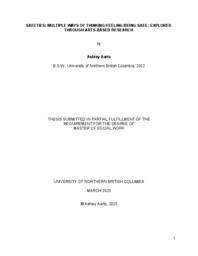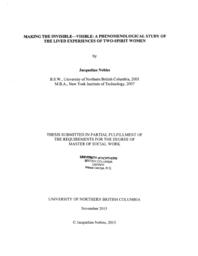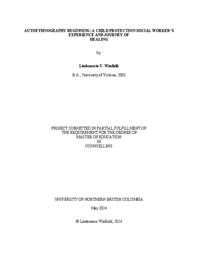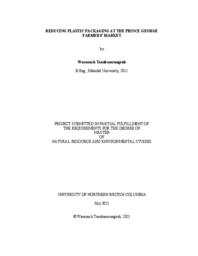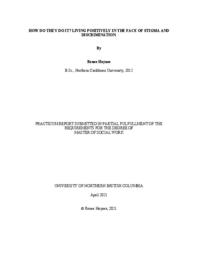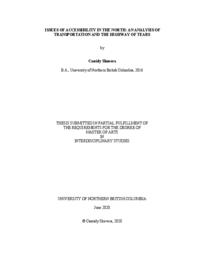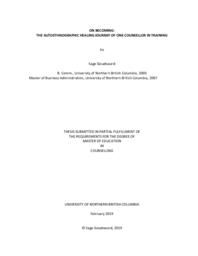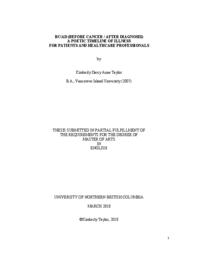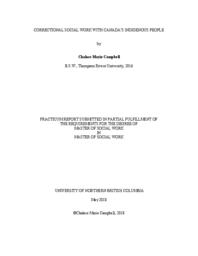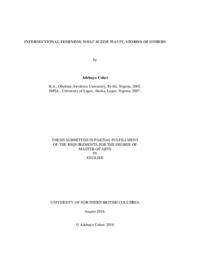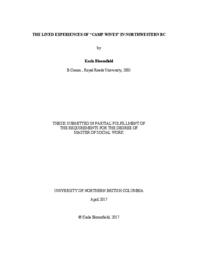Transken, Si
Person Preferred Name
Si Transken
Related Works
Content type
Digital Document
Description / Synopsis
This report outlines my practicum experience as a Child and Youth Mental Health
(CYMH) counselor at Connexus Community Resources from July 2024 to February 2025. I
completed my practicum on the clinical services team at Connexus which allowed me to get a
sense of the different programs and services provided by the agency while focusing on clinical
counseling. The report outlines my learning goals, which include developing skills in different
therapeutic modalities (specifically Cognitive Behavioural Therapy [CBT] and play therapy) and
using these skills to address complex trauma, as well as to learn how to utilize different
counselling skills cross culturally; these goals are all pointed towards my overall goal, which was
to start developing my identity as a clinical social worker in the north. My personal positioning
and theoretical orientation, specifically how my social location shapes my current practice and
how I follow a social constructivist strengths-based approach, are explored. A literature review
highlights five topics that formed the foundation of my learning goals and shaped my practicum:
complex trauma, the therapeutic relationship and play therapy, CBT and Trauma-Focused CBT,
northern practice, and cross-cultural work with Indigenous children and youth. A discussion of
my learning experience highlights the progress I made in completing my learning goals as well
as demonstrates some of the challenges I encountered, such as in learning how to shift my lens
from a child welfare perspective to a clinical perspective.
Origin Information
Content type
Digital Document
Origin Information
Content type
Digital Document
Origin Information
Content type
Digital Document
Origin Information
Content type
Digital Document
Description / Synopsis
Equine assisted therapies are growing in popularity as a modality for treating various mental health and developmental challenges. Many of these challenges require focused work on the development of empathy, perspective taking, and attunement to self and others. This study examines the participants’ experiences and understanding of empathy as it relates to self, humans, and equine partners via structured qualitative interviews with four therapy participants. The interviews conducted for this study demonstrated a distinct common understanding of empathy as the ability to take perspective based on the human’s or animal’s own orientation in the world; an understanding that developing empathy within the context of equine therapy was emotionally laborious and required significant work and emotional engagement on the participant’s behalf. The interviews indicated that the participants’ perceived the horse as emotionally neutral in therapeutic interactions. Furthermore, the study indicated that a central component to the perceived success of this modality of therapy was a parallel process in relationship between the facilitator/client dyad and the client/equine dyad.
Origin Information
Content type
Digital Document
Description / Synopsis
In this report I discuss my practicum experience at Carrier Sekani Family Services and my work with the Child and Youth Mental Health Team during the summer of 2021. I review the agency I worked with, including an overview of the services they offer and its mission. My personal positioning and theoretical orientation are outlined, with a specific focus on how social location impacts my work, social constructivism, and strength-based framework. A literature review is provided in which four topics related to my practicum are reviewed: child and youth mental health, Indigenous child and youth mental health, the importance of providing services to children and youth, and practice considerations. I discuss my practicum learning experience and focus on the theme of holistic practice. Finally, I review how my practicum experience will impact my future practice and how my learning will benefit me and my future clients.
Origin Information
Content type
Digital Document
Description / Synopsis
Contextualizing clinical social work practice was the goal of the 450 practicum hours I completed at Walmsley and Validity Counselling Services. The practicum report starts with an overview of clinical social work practice and provides a detailed history of the practicum agency, services offered, and funding. In the following chapters, I explore and weave myself into the theoretical orientations that ground my practicum practice. Also, there is a salient review of literature necessary to contextualize clinical practice, especially in Northern British Columbia. From the practicum experience, I drew connections between the contextualization of clinical social work practice and key elements such as reflexivity, supervision, and training.
Origin Information
Content type
Digital Document
Description / Synopsis
This report focuses on the clinical social work skills and knowledge I gained during my Master of Social Work (MSW) practicum at the Warrior Support Centre in Mental Health Services with the 2 Field Ambulance unit at Garrison Petawawa in Petawawa, Ontario. My theoretical frameworks that guided my learning included General Systems Theory, Ecosystems Perspective, and Feminist Theory. My chosen methodology was discourse analysis to deepen my understanding and learning experiences. Literature on the Canadian Armed Forces (CAF), military social work, mental health, and stigma in the military informed my construction of knowledge and observations. This report outlines my overall learning goals and objectives in clinical social work practice supporting active military members. My experiences, observations, clinical skill development and subsequent practice implications are explored at length.
Origin Information
Content type
Digital Document
Description / Synopsis
In this thesis I draw on deconstruction theory and queer theory to analyze the current representation of sex, gender, and sexuality in Canadian television. Through this research I found that although Canadian television is portraying an increasing number of queer genders and sexualities, misinformation and stereotypes continue to perpetuate a one-dimensional characterization of people. This research pertains directly to my creative thesis: a pilot episode of a TV series which fraternal twins, Jed and Theodora, grow up with the ability to switch into one another's body. I dive directly into the correlation between sex and gender and the lived experience of being in a body that does not necessarily represent gender. The will both create a new gendered "construction" as well as question the need for gender identifications.
Origin Information
Content type
Digital Document
Description / Synopsis
Plastic pollution, a global problem, contributes to detrimental impacts on the environment. To mitigate plastic pollution locally,farmers’ market scan play a role in reducing plastic consumption. Many studies have suggested that customers and vendors are aware of environmental problems. Yet vendor environmental awareness does not always result in appropriate actions, as many vendors still rely on plastic packaging. To investigate the reasons for such reliance, I conducted vendor interviews and a customer survey at the Prince George (B.C.) Farmers’ Market. The results show that the barriers to reducing plastic include packaging availability, characteristics, functions, and price. Based on interview results, I developed a manual to support vendors interested in reducing plastic packaging at their stalls. I also offer recommendations as to how policy makers can motivate vendors and customers to reduce plastic consumption, such as offering customers reusable bags and organizing plastic-free events.
Origin Information
Content type
Digital Document
Description / Synopsis
In literature and film, werewolves have gone through an incredibly varied series of portrayals, but, throughout all of their changes (cycling largely between being antagonists and protagonists), werewolves have always interacted with the essentialist concept of the human-animal binary. Mutable at their core, werewolves reflect the people, places, and times of their various manifestations; the werewolf is whatever we need it to be. The fact that werewolves are inherently liminal creatures means that, for the purposes of my thesis' discussion, werewolves can serve as a tool for addressing preconceived notions of human exceptionalism (i.e., anthropocentrism). I question the assumptions of boundaries and socalled human traits with a story about embracing the uncertainty that our classifications and labels seek to efface. Simultaneously, I draw attention to female werewolves to level a concurrent challenge against patriarchal scripts that denigrate the association of human females with non-human animals. Just as many historical portrayals of werewolves reinforce the negative connotations of a woman-animal alignment, so too do contemporary representations of female werewolves become subject to portrayals that reinforce patriarchal values, rather than challenge them. Therefore, my focus is two-fold: to present an alternative narrative (in the form of a theory piece married to a novel) that draws attention to the artificial nature of both anthropocentrism and androcentrism. These two ways of thinking—that humans are inherently more important than animals and that the perspectives of male humans, in particular, trump all other points of view—are inextricably linked in their ideological othering of alternative experiences of being. The female werewolf, an embodiment of both inferior entities, is a well-suited symbol to decentralize dominant patriarchal narratives. Presented herein is my theory piece and the first fifteen chapters of my novel, Then, We Were Wolves, Again. It is a story about a woman who becomes the wolf she was all along and a man who undergoes a transformation but does not change. As a human, the protagonist, Harley, drifted through life like a lone wolf, but now, as an actual werewolf, she struggles to reconcile her instinctual need for her pack with her growing sense of disenchantment with her fellow lycanthropes. Indoctrinated by their leader, Arden, they're convinced of their sovereignty as a superior species to humans, but this new werewolf picks away at the cracks of hypocrisy, revealing the same species-centric thinking the wolves claim to transcend.
Origin Information
Content type
Digital Document
Description / Synopsis
Exploring the experiences of people who build a casket for a loved one is not clearly delineated in academic literature. This study focused on identifying and sharing the experiences of people who engaged in casket building for a loved one. The purpose of the research was to explore and interpret people’s experiences with casket building. Using an interpretive description approach and thematic data analysis, my research encompassed the experiences of four people who engaged in casket building for a loved one. Ultimately, four themes were generated: 1) A Desire for Something Different, 2) Influential Death Rituals, 3) The Importance of Relationships, and 4) Maintaining Wellness. The research supports those who may choose to follow in their footsteps. The study also encourages social workers to utilize practices, which some may consider non-traditional, to best meet the needs of the populations they serve.
Origin Information
Content type
Digital Document
Description / Synopsis
In reviewing the literature it is apparent that HIV diagnosis and treatment has improved greatly over the years. Treatment is now simpler with fewer side effects and the concept of U=U, having an undetectable viral load means the virus is untransmittable, has given many women more confidence to lead healthy and positive lives. Many women are supported by the work of organizations such as Positive Living North which allows them a place to access nonjudgmental peer interactions and acceptance. The purpose of this report is to summarize my practicum experience at the Positive Living North: No khe̅ yoh t'sih'en t'sehena Society (PLN) in Prince George, British Columbia. This report outlines my expectations and goals within my practicum and how my learning objectives were met through observation, discussion, and practice. This experience allowed me to examine and reflect upon inherent biases as well as reimagining my future practice as a social worker.
Origin Information
Content type
Digital Document
Description / Synopsis
The Highway of Tears is a term that is known across northern British Columbia. Since 1969, women and girls have gone missing and been found murdered along the 724 km stretch of Highway 16 between Prince Rupert and Prince George, British Columba. Many of these women were trying to get from one destination to another when their safety was compromised. These individuals were from communities with few transportation options available and where hitchhiking is a common form of transportation. Using an interdisciplinary perspective including northern studies, political science, and women’s studies I will analyze the issues of transportation in the north in connection to the Highway of Tears case. In particular I will examine how the Highway 16 Transportation Action Plan developed in order to determine what happened and why it took ten years for a policy response to emerge that addressed safety concerns and transportation gaps in the north.
Origin Information
Content type
Digital Document
Description / Synopsis
This study is an exploration of the intersectionality of my two identities, lesbian and social worker, within the northern British Columbia (BC) mental health workspace. By taking a transformative stance and making use of queer methodology, I present my voice as both the researcher and the researched. My data sources are based on past recollections and a collection of personal poems, reflections, stories, journal entries, sketches, collages, and photographs. Through autoethnographic accounts, I examine experiences as my identities intersect and become the focus of workplace bullying and harassment within the setting of northern British Columbia (BC) mental health system. I also examine the personal and professional costs of using internal agency and provincially legislated protocols and policies in challenging workplace bullying and harassment behaviour, such as the little-known topic of disenfranchised grief.
Origin Information
Content type
Digital Document
Description / Synopsis
Counsellor identity development is a unique and challenging journey which involves both academic training and personal formation. Research shows that who the counsellor is, personally and interpersonally, is of greater impact in the therapeutic alliance than theory or technique. The counsellor's ongoing individual work on self, experiences in life, and growth in self-awareness, empathy, and compassion are important tasks as the counsellor moves from a novice counsellor to a master therapist. This thesis is meant to add to the body of research on counsellor identity development following the progression of a counsellor in training through this process. Evocative autoethnography was utilized to provide a deeply personal perspective of the process and change that occurred. It was found that spirituality, creativity, and play, as well as the integration of emotional, mental, and somatic parts of self were essential elements of this transformational journey of becoming.
Origin Information
Content type
Digital Document
Origin Information
Content type
Digital Document
Origin Information
Content type
Digital Document
Origin Information
Content type
Digital Document
Origin Information
Content type
Digital Document
Origin Information
Content type
Digital Document
Origin Information
Content type
Digital Document
Origin Information
Content type
Digital Document
Origin Information
Content type
Digital Document
Origin Information


